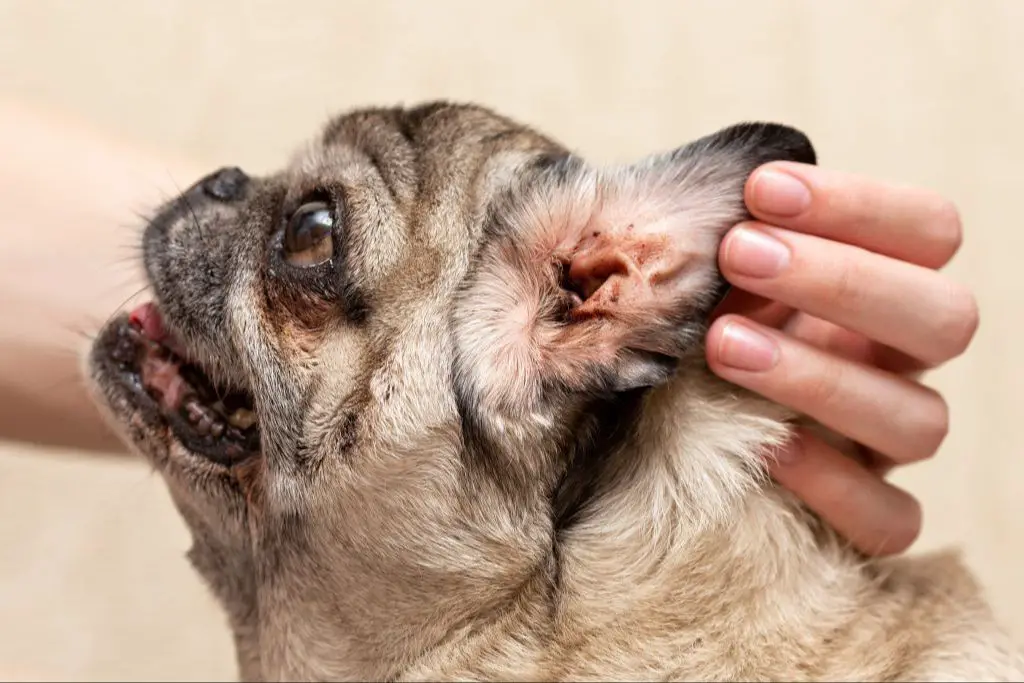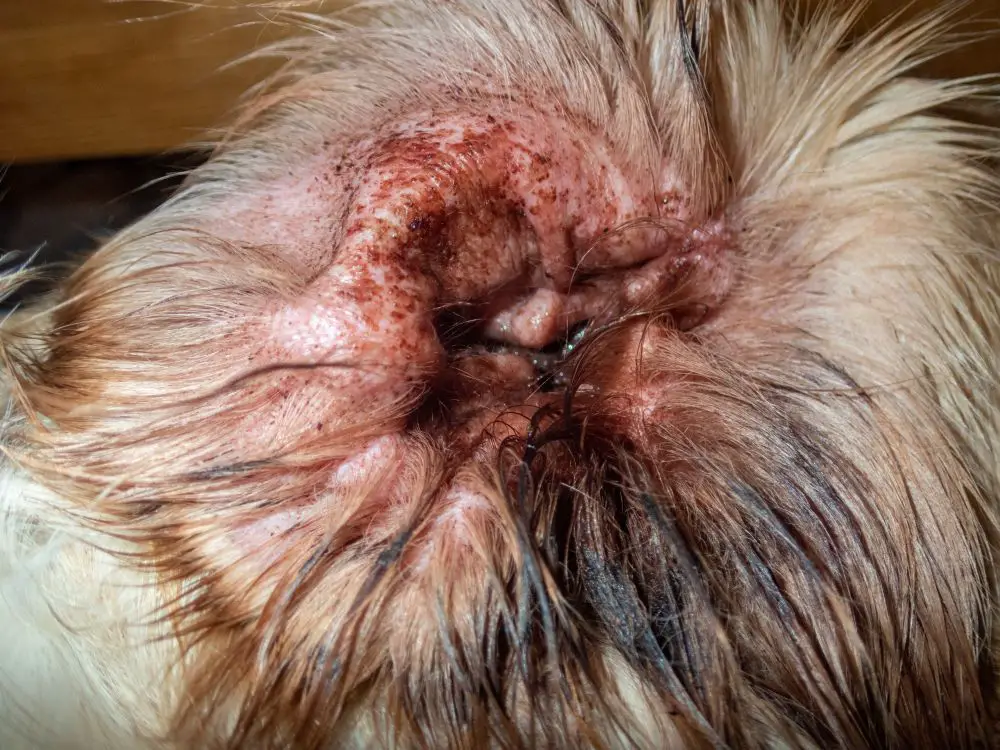What Causes Ear Infections in Dogs
Ear infections in dogs are often caused by too much moisture in the ear canal, which provides an environment for bacteria, yeast and fungi to grow. Common sources of excess moisture include:
- Swimming or bathing – Water gets trapped in the ear canal and does not fully evaporate.
- Allergies – Allergies can lead to increased discharge and itchiness, causing dogs to shake their head and ears, trapping moisture inside.
- Foreign objects – Things like foxtails, grass seeds or dirt/debris can get lodged in the ear canal and irritate the skin, leading to infection.
- Excessive hair – Long, hairy ears or hair growing in the ear canal prevents air circulation and traps moisture inside.
The moist, warm environment created allows bacteria, yeasts and other microorganisms to thrive and multiply, leading to infection. Therefore, it’s important to thoroughly dry ears after swimming or bathing, regularly pluck excess ear hair, treat any underlying allergies, and remove any foreign material from the ears to prevent excess moisture buildup.
Signs of an Ear Infection
There are some clear signs to look out for that may indicate your dog has an ear infection:
- Head shaking or head tilting – A dog with an ear infection may shake their head or tilt it to one side in an attempt to relieve discomfort in their ears.
- Scratching or rubbing at the ears – The irritation caused by an infection leads to itchiness, so scratching or rubbing at the ears is common.
- Redness and swelling inside the ear – Inflammation develops as the infection progresses, causing the inside of the ear to become red and swollen.
- Brown, yellow, or bloody discharge – Infected ears often produce discharge, which can be reddish-brown or yellow, and may contain blood.
- Black debris or crusty buildup – Yeast and bacteria can cause a dark, crumbly buildup inside the ears.
- Unpleasant odor – Infections cause an unpleasant smell coming from the ears.
- Sensitivity to touch – Dogs may cry out or pull away when the infected ear is touched.

If your dog shows several of these symptoms, it’s likely they have an ear infection that requires treatment. The earlier treatment begins, the faster the infection can be cleared up.
Risks of Not Treating an Ear Infection
If your dog’s ear infection is left untreated, there are several serious risks that can develop. The most significant risk is that the infection can worsen and spread further into the ear canal, even rupturing the ear drum in severe cases. The intense inflammation and pain from the infection can become unbearable for your dog. Here are some of the potential risks of leaving ear infections untreated:
Pain – An ear infection causes significant pain and discomfort for dogs. As the infection worsens, the pain intensifies. Dogs with untreated chronic ear infections are in constant agony.
Rupture of ear drum – The inflammation from the infection puts pressure on the ear drum. In some cases, this can cause the ear drum to rupture. A ruptured ear drum can lead to long-term hearing loss.
Spread of infection – Ear infections easily spread down the ear canal and to other areas like the sinuses if left untreated. Bacteria and yeast can invade deeper into the ear and skull.
Hearing loss – The longer an ear infection persists, the higher the chances of permanent hearing damage. The infection erodes the sensitive structures of the ear over time.
Loss of balance – Dogs rely on their ears for balance and coordination. Untreated infections throw off their equilibrium and cause dizziness, disorientation, and falling over.
By promptly treating an ear infection as soon as you notice symptoms, you can help your dog avoid unnecessary suffering and prevent future complications. Don’t wait and hope an ear infection resolves on its own – seek veterinary attention right away.
When to See the Vet
While mild ear infections can often be treated at home effectively, there are some signs that indicate it is time to take your dog to see the veterinarian:
- Severe pain – If your dog is crying, scratching excessively at their ears, or seems to be in extreme discomfort, a vet visit is warranted.
- Total loss of hearing – If your dog seems unable to hear at all, this indicates an advanced infection that requires professional treatment.
- Neurological symptoms – If your dog is tilting their head, walking in circles, losing balance, or displaying uncoordinated movements, they need to be evaluated by a vet immediately.
- Poorly responsive to home treatment – If your dog’s infection persists or worsens despite a week of home treatment, veterinary assistance is required.

Ear infections left untreated can result in permanent damage to the ear canal and eardrum. Don’t delay – make an appointment with your vet right away if your dog exhibits any of these concerning symptoms. A chronic or advanced infection often requires prescription medication to fully resolve.
Cleaning the Ear Canal
Keeping your dog’s ears clean is one of the best ways to prevent and treat minor ear infections at home. Here are some tips for properly cleaning your dog’s ears:
Start by purchasing a high-quality dog ear cleanser solution from your veterinarian or pet supply store. These solutions are specially formulated to gently wash away dirt, debris, and wax.
Apply a small amount of the ear cleaner to a cotton ball or pad. Never pour the solution directly into your dog’s ear.

Gently wipe out any visible dirt, discharge, or debris from the outer ear canal and ear flap. Be very gentle, especially if your dog’s ears are inflamed or sore.
Never insert a cotton swab, tip, or any other object down into your dog’s ear canal, as this can damage the delicate inner ear structures.
Wipe away any excess solution and allow your dog’s ears to fully dry. Praise and reward your dog for cooperating with the ear cleaning.
Clean your dog’s ears once a day when treating an infection. For prevention, clean ears once a week or as recommended by your veterinarian.
Proper ear cleaning removes debris to allow medication to work, while also calming inflammation and preventing recurrent infections.
Using Topical Medications
Once the ear canal is clean, you can apply a topical medication to help treat the infection. There are several over-the-counter topical medications made specifically for dog ear infections that you can pick up from your vet or pet store. These usually contain an antifungal, antibiotic, anti-inflammatory, or antiseptic agent.
Be sure to follow the label directions closely when applying any medication in or around your dog’s ears. Usually you will need to fill the ear canal with the medication, gently massaging the base of the ear to work it in. Then keep your dog’s head tipped to the side for a few minutes so the medication can penetrate.
It’s important to let the medication dry completely before allowing your dog to shake their head or get their ears wet. This allows sufficient contact time so the medication can work effectively. Applying topical medications for the recommended number of days, even if symptoms appear to resolve, is key to fully eliminating the infection.
Keep a close eye on your dog after applying ear medications, as some dogs may try to rub their head or ears excessively. You may need an e-collar to prevent them from injuring their ears.
Topical ear medications should only be used as directed, and discontinued if any worrisome reactions occur. Never use topical ear products not specifically approved for dogs. And be cautious about using leftover medications from a prior infection, as they may be expired or otherwise inappropriate.
Oral Antibiotics and Anti-inflammatories
Oral antibiotics and anti-inflammatory medications should only be given to dogs under the direction of a veterinarian. It can be tempting to use antibiotics or anti-inflammatory medications intended for human use, but dogs have different metabolic processes and doing so can actually harm your pet. Your vet will prescribe the appropriate medication in the proper dosage for your dog’s ear infection.
Typically, oral antibiotics are used for bacterial infections while anti-inflammatories help reduce swelling, redness, and pain. It is crucial to follow your vet’s instructions and give your dog the full course as prescribed, even if symptoms seem to clear up. Stopping medication early can lead to recurrence of infection with antibiotic-resistant bacteria.
Check with your vet before giving any human medications to dogs. Many common over-the-counter drugs like ibuprofen can be toxic for pets. Trust your vet to provide the right oral medications to get your dog’s ear infection under control.
Soothing Home Remedies
While home remedies should not take the place of professional veterinary care, some natural solutions may help soothe irritation and provide relief alongside other treatments. However, it’s important to consult your vet before using any home remedy, as some ingredients may cause further irritation or interfere with medications.
Here are some gentle home remedies that may help calm inflamed or infected ears when used carefully:
Warm Compress
Applying a warm, moist compress to the outer ear area can help promote circulation and drainage. Be sure the compress is not too hot to avoid burning delicate skin. You can soak a clean cloth in warm water, wring out excess moisture, and apply for 5-10 minutes as needed.
Aloe Vera Gel
The soothing properties of aloe vera may help reduce swelling, redness, and discomfort. Look for pure aloe vera gel and apply a small amount around the outer ear canal opening 1-2 times per day. Never insert aloe vera or other home remedies down into the ear canal.
Apple Cider Vinegar
The antibacterial and anti-fungal properties of diluted apple cider vinegar may help fight infection while balancing pH levels. Mix equal parts apple cider vinegar and sterile water or saline solution. Use cotton balls to gently wipe the clean outer parts of the ears with the solution 1-2 times per day after checking with your veterinarian.
When using any home remedy, monitor your dog closely for signs of irritation or worsening infection. Stop use and contact your vet if symptoms do not improve within 2-3 days.
Preventing Recurrence
Once your dog’s ear infection has cleared up, there are several things you can do to help prevent it from coming back:
Keep ears clean and dry – Check and gently wipe your dog’s ears weekly to remove any dirt, debris or moisture. After baths or swimming, thoroughly dry your dog’s ears. Excess moisture creates the perfect environment for infection.

Treat allergies – Allergies are a common cause of chronic or recurring ear infections in dogs. Working with your vet to manage skin allergies, food allergies or environmental allergies can help prevent flare ups.
Don’t use irritating cleaners – Some ear cleaners and drying agents contain harsh ingredients like alcohol that can irritate the sensitive ear canal. Use a mild, natural cleaner recommended by your veterinarian.
Check for foreign objects – Make sure there are no foreign materials, like grass seeds, stuck deep in the ear canal that could cause recurring irritation and infection.
Staying on top of ear care, allergies and avoiding irritation is the best way to stop ear infections before they start. If your dog has frequent infections, work with your vet to identify the underlying cause and create a prevention plan.
When to Retest and Follow Up
Even if your dog’s ear infection symptoms seem to have improved after home treatment, it’s crucial to retest after 7-10 days. Ear infections can often come back after appearing to be cured, so you’ll want your vet to do a follow-up exam of the ears. They may require continuing the medication for an extended period beyond when the symptoms disappear. This ensures the infection is completely gone before stopping treatment. Don’t discontinue medication early or skip follow-ups, as this risks the infection returning.
At the recheck appointment, the vet will flush the ears again and examine them with an otoscope. They will determine if the infection is gone by looking for any remaining redness, inflammation, or debris. If present, treatment may need to continue for another 7-10 days. It can take up to 4-6 weeks of medication for a severe or chronic ear infection to fully resolve.
Don’t get discouraged if it seems like the ears are not getting better. Ear infections require diligence to treat. Work closely with your veterinarian and follow their prescribed treatment plan to give your dog the best chance of being cured.